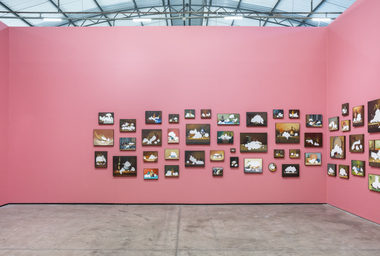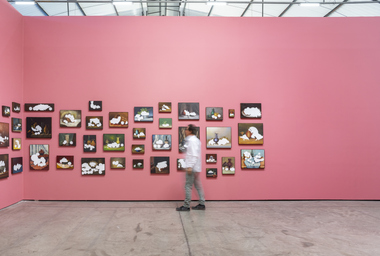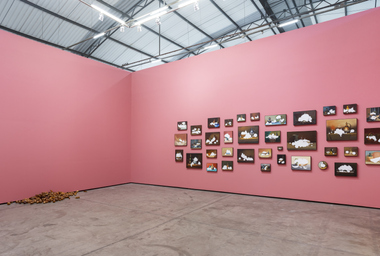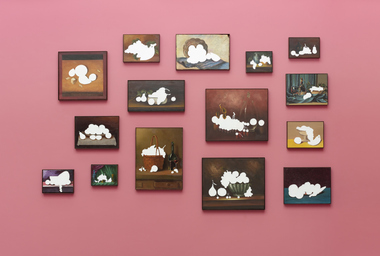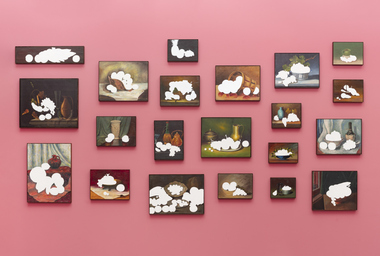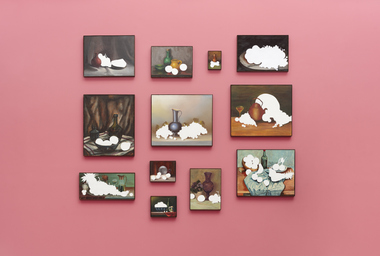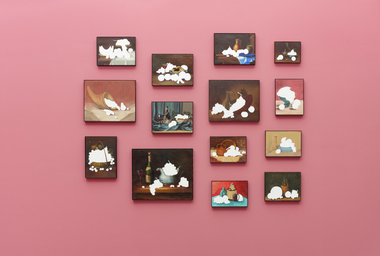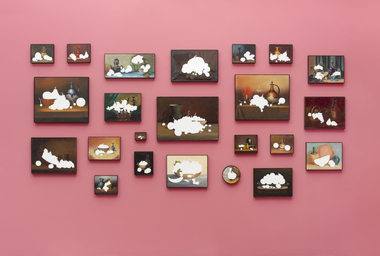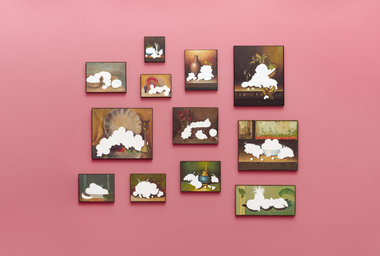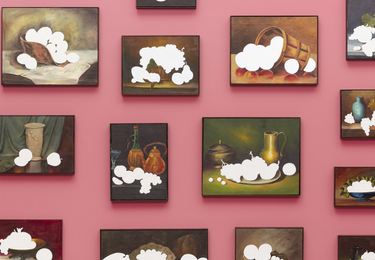
Valeska Soares
Equivalents
Jun 25 – Aug 13, 2022
Opening
Jun 25, 3 pm–6 pm
FDAG Barra Funda
Download
Throughout the process of the new body of work presented at Equivalents, Valeska Soares’s new solo show at Galpão, the artist purchased more than a hundred anonymous still-life paintings from around the world, appropriating and repurposing them by erasing the images of fruits with white paint, leaving apparent just the corresponding outlines. The works, painted in oil on different surfaces (canvas, wood, paper), have different sizes and make up a salon hanging on a pink background. The installation alludes to issues of desire and memory and further develops the artist’s research on genres of the Art History canon. An essay by curator Marília Loureiro develops critical thinking on the show.
The Spear and the Basket1
By Marilia Loureiro
“In the first century, “Rhyparographer!” would have been the insult for those who painted fruits, flowers, fish and game, jars, vases, baskets and plates in everyday scenes. The “rhyparographer” is the painter of everything that is dirty, sordid, and morally and physically impure2 . It was the naturalist Pliny (23-79 AD), in his encyclopedia Natural History, who first coined the term “rhyparography’, which would later be turned into the softer synonym “rhopography”, meaning the representation of small, trivial, unimportant, worthless things. If rhopography occupies the low ranking of painterly genres, “megalography” — the painting of exceptional acts, illustrious characters and events that changed the course of history — is its opposite.3
What all examples of “rhopography” have in common is the everyday scenes that silently support the reproduction of life. Consistently, these scenes evoke the repetition of ordinary tasks, small decisions with regards to resources, the taking care of domestic objects and the different species that we use for food. Even though what later would be called still life4 is marked by the absence of the human figure, it is not difficult to assume that the human body belongs in those scenario. It is also pretty easy to notice the body that stars in “megalographic” paintings, which are full of battles, conflicts and, of course, heroes. Perceived as art history’s finest genre, historical paintings celebrate virtues such as bravery, power, rationality, determination, and sacrifice. This gender division of imagery, separated according to female and male attributes, organizes not only a certain hierarchy of painting, but most of all the way in which scenes of world transformation are narrated, in contrast with what has been understood as a still life (literally, quiet life), unremarkable and meaningless.5
It is the non-heroic and apparently unimportant narratives that the work of Valeska Soares turns to. In Equivalents (2021), the artist brings together 119 still life paintings. Painted by unknown painters and bought by the artist in different places around the world, the paintings feature different dimensions and techniques. Similar to previous works, such as Un-rest (2010), Any Moment Now… (2014) and Doubleface (2017-2021), the act of collecting is what precedes and gives texture to the work. Above all, these are objects that keep marks, that crystalize habits, that accumulate stories and absorb time. These are objects that have had different lives. But far from pacifying this set of paintings into a collection, the artist engages them in new networks of meaning, which are full of mystery.
The fruits have disappeared from the paintings. Their outlines are all that is left. In volume-less white planes, the fruits’ outlines oscillate between absent figuration and organic abstraction, without ever settling for one or the other. Part of the figure has been erased, like in a memory lapse. Tantamount to the organic matter on the table, memory also deteriorates. At this point we come to the conclusion that the trigger behind Equivalents is loss. Faced with the gap of loss, Soares invites us to experience the fascination with the inaccessible. And once we realize we can no longer rebuild what is missing, we are left with yearning. Yearning as the force that creates the world is called upon so we can imagine what is not there, create what is yet to come and fill in the blank spaces. In a number of works produced by the artist, the interdiction of one image opens up the possibility to “imagine the image” of many others.
Soares interdicts while inviting, deprives while offering. Whatever has been erased from the painting in Equivalents is materialized into objects: there are several wooden fruits scattered on the floor, as if they had been swept to the corner of a room. Fruits that are missing here, are abundant over there. Soares is constantly shaping dualities, without ever fixating on a single part. In the interval between one and the other, between interdicting and inviting, between lack and excess, the artist engages us in her insoluble scheme, and invites us to stay a bit longer with the work. It is precisely in this intermission that the mystery lies. And faced with the vain attempt to reveal it, we come to inhabit this space of indetermination, where time is not the time of clocks. There is no possible seduction without an interval.
Let us go back to the opposition between the “megalographic” image of the spear and the arrow, and the “rhopographic” image of the fruit basket. Running counter to the hetero-political6 binarism that we have inherited, the work of Soares creates slippery narratives, which exceed and escape widely perceived universal values. In her story of apparently small things, there are no heroes. Instead, they are all potential characters that fit in a basket — the fruits, a book, a pillow, a box of chocolate and so many other objects that populate her works7. Brought together in a vast body of works, they relate to each other creating interactions where impulse comes before battle, delirium comes before rationality, desire comes before triumph, and mystery comes before the predictable “grand finale”. Here, temporality does not follow the speedy and linear chronology of epic progress that annihilates intervals, but is conjured in gaps and dualities, curves and instable twists. Valeska Soares is not interested in the transformation by spear and arrow, which stabs, hits, pierces and narrates the history of the assassin — or the history of civilization — but in the transformation that happens inside a basket, which welcomes, gathers, transports, involves and gestates other stories — the stories that stitch life.8
—
1 Title inspired by the essay “The Bow and the Basket” by anthropologist Pierre Clastres.
2 Bryson, Norman. Looking at the Overlooked: Four Essays on Still Life Painting. London: Reaktion Books, 1990. p. 136.
3 Ibid. p. 61.
4 The word “stilleven”, which would later be translated into the English term “still life”, first appeared in Holland in the 17th century. In France, the term used is “nature morte” [dead nature], which originated the Portuguese term “natureza morta”.
5 On the gender division of images of transformation, see Alana Moraes’ essay “Política como prática de experimentação”, published in Jornal Nossa Voz, edition 1020. Casa do Povo, 2019-2020.
6 https://cedla.org/reflexiones-sobre-la-crisis/contra-la-binariedad-heteropolitica-en-respaldo-a-segato-galindo-y-rivera/
7 Here, other works by Valeska Soares are called to mind, Equivalents (2021), Edit (2012), Duet (2002) and Sugar Blues (2013), respectively.
8 In the essay “The Carrier Bag Theory of Fiction” (Ignota Books, 2021), Ursula Le Guin develops the theory that the first cultural apparatus was a basket rather than a spear, and uses this premise to articulate the narratives of fiction.
